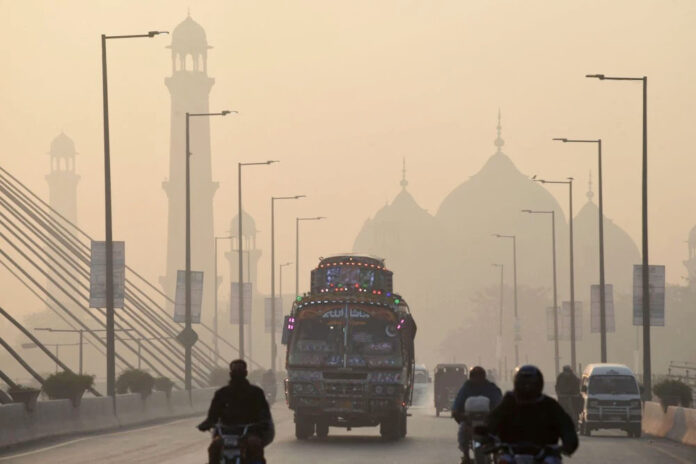Every winter, a thick veil of smog descends upon cities in Pakistan and India, transforming vibrant urban landscapes into unrecognizable silhouettes and suffocating the lives of millions. This seasonal crisis, particularly acute in Punjab’s Lahore and other major cities like Karachi and Delhi, has become a stark reminder of the environmental challenges that both nations face. As air quality deteriorates, with Lahore consistently ranking as one of the world’s most polluted cities—recording Air Quality Index (AQI) levels that soar to 394, nearly four times above healthy thresholds—the urgent need for a robust and comprehensive response has never been clearer.
The origins of this smog crisis are well-documented and include vehicular emissions, industrial pollution, and perhaps most notoriously, the annual burning of crop residue. Farmers, in their race to clear fields for the next planting season, resort to this age-old practice primarily due to a lack of viable alternatives and inadequate support from agricultural policies. The incentive structure in place often leaves them with few choices, and while states like Punjab and Haryana in India have implemented punitive measures against stubble burning, these approaches have proven largely ineffective. Rather than fostering sustainable practices, they often push farmers into further economic distress, perpetuating the cycle of pollution that envelops these cities.
The smog dilemma confronting South Asia is not insurmountable, but it requires a collective and committed effort. Both Pakistan and India must move beyond short-term fixes and engage in proactive measures that tackle the root causes of air pollution. By investing in sustainable agricultural practices, fostering technological innovation, promoting international collaboration, and enhancing public awareness, we can aspire to breathe clean air again. The health and well-being of millions depend on the actions we take today. The time for change is now, and the path to a cleaner, healthier future lies in our willingness to confront these challenges head-on. Only through collaborative and sustained efforts can we hope to navigate this air quality crisis and reclaim our right to breathe freely
In Pakistan, the situation mirrors that of its neighbour, yet the response has been alarmingly reactive rather than proactive. Recent years have seen the government roll out measures such as adjusting school timings, banning fireworks, and promoting public awareness campaigns about the dangers of smog.
However, these actions fall short of addressing the root causes of the issue. For instance, the establishment of ‘Anti-Smog Squads’ in Pakistan, aimed at monitoring and educating farmers about the risks associated with stubble burning, has yet to gain widespread traction. These squads can only be effective if coupled with substantial governmental support for sustainable farming practices.
To navigate this smog dilemma effectively, a multifaceted approach is essential. Both countries must invest in innovative agricultural technologies that provide practical alternatives to burning. Subsidizing machinery for residue management— like super-seeders that can plant crops directly into the stubble— could offer a long-term solution while alleviating the burden on farmers. Furthermore, collaboration between India and Pakistan on climate initiatives could yield significant benefits. Shared technologies and strategies, such as joint research and development programmes, could help both nations tackle their air quality issues more effectively.
Moreover, it is crucial to recognize that agriculture is not the sole contributor to this environmental crisis. Industrial emissions and vehicular pollution also play significant roles in degrading air quality. Transitioning to renewable energy sources, such as solar and wind, can help reduce reliance on fossil fuels, a key contributor to air pollution. Investing in infrastructure that supports public transport can significantly reduce traffic congestion and emissions. By enhancing public transportation systems, both countries can promote a shift from private vehicle use to more sustainable modes of transit, which is vital for addressing air pollution in densely populated urban areas.
International collaboration can further enhance these efforts. Countries facing similar air quality challenges have begun to share best practices and technological advancements. For instance, in China, which has successfully implemented rigorous pollution control measures, lessons can be learned and adapted for use in Pakistan and India. From monitoring air quality to enforcing stricter regulations on emissions, the exchange of strategies and tools is vital. Collaborative efforts, such as joint conferences or workshops focusing on environmental sustainability, can serve as platforms for dialogue and innovation, encouraging cooperation between governments, NGOs, and local communities.
Additionally, public awareness and education are paramount in tackling this dilemma. Engaging citizens in understanding the impacts of air pollution and encouraging sustainable practices at the community level can foster a sense of responsibility and agency. Campaigns that promote tree planting, reducing waste, and alternative transportation methods can create a grassroots movement that complements governmental efforts. Educational institutions should also play a vital role in this regard, integrating environmental education into their curricula to empower future generations with the knowledge and skills to combat these pressing challenges.
The financial aspect of this crisis cannot be overlooked either. Investments in sustainable practices and technologies must be prioritized in national budgets. Governments should consider providing incentives for businesses and industries that adopt greener practices, as well as for farmers transitioning to more sustainable methods. This financial support can alleviate the burdens faced by those most affected by air pollution while encouraging the private sector to play a proactive role in creating sustainable solutions.
The smog dilemma confronting South Asia is not insurmountable, but it requires a collective and committed effort. Both Pakistan and India must move beyond short-term fixes and engage in proactive measures that tackle the root causes of air pollution. By investing in sustainable agricultural practices, fostering technological innovation, promoting international collaboration, and enhancing public awareness, we can aspire to breathe clean air again. The health and well-being of millions depend on the actions we take today. The time for change is now, and the path to a cleaner, healthier future lies in our willingness to confront these challenges head-on. Only through collaborative and sustained efforts can we hope to navigate this air quality crisis and reclaim our right to breathe freely.






















